Several thousand bottles of wine from the previous century lie in the cellar of Breuer's Rüdesheimer Schloss and many of them are available to guests of the restaurant at fair prices. Once a year, however, Bernhard Breuer also allows a more detailed insight into the qualities from earlier decades with his rarity tasting. This was also the case on 14 February this year, when a small circle of passionate wine lovers met at the castle to spend an evening with the excellent castle cuisine and, among other things, with the testimonies of a golden age of Rheingau viticulture.
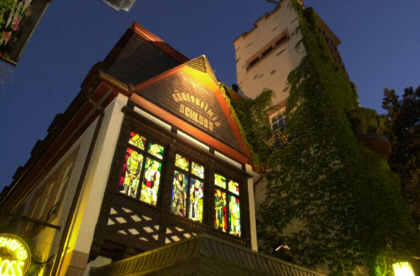 |
| Rüdesheim Castle |
It started with moderately old wines, a 94 Rauenthaler Baiken Beerenauslese from the cellars of the StaatsweingutsThis wine impressed less with its concentration than with its elegance, purity, fine play and great length. A wonderful wine from a rather difficult vintage, which only really matured in top vineyards (93).
1964 was not exactly a great vintage either. The year in which Martin Luther King was awarded the Nobel Peace Prize while Jean-Paul Sartre turned down the prize for literature, made headlines mainly because of the record yield of almost 105 hectolitres per hectare on average at the time. The Beerenauslese from the Hallgartener Schönhell of Carl F. Engelmann The generous harvest is also noticeable, but despite the slender body and the rather moderate sweetness, there was still a wine in the glass with the best drinking maturity: fine, floral and slightly planty peach honey nose; in the mouth clear, slender, slightly mineral, again honey, also oranges and delicate spice, not really long, but very nice to drink (88).
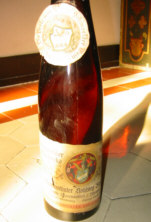 |
| 34 Mariensthal Hollow |
The "sun year" of 1934 also had a record yield, only then it was only 62 hectolitres per hectare! It was nevertheless a black year for the German Winegrowers' Association - it was dissolved, but for wine it was one of the greatest of the century. Thus the Martinsthaler Hohlweg feinste Beerenauslese from the trading house's own vineyards also presented itself Schmoelder & Goedecke almost timeless, with a beautiful, deep and oxidative bouquet of wilted blossoms, honey and dried fruit, a densely woven, finely spicy fruit with fantastic acidity and perfect sweetness (96). If the first two wines still had slight difficulties with the black pudding casserole served with the series, an ideal companion was found here.
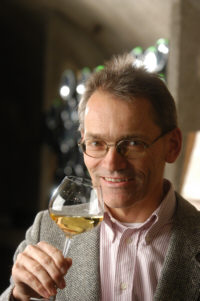 |
| Bernhard Breuer - a lover of old wines |
With the venison tartare and purslane salad, he presented his four Bernhard Breuer presented his four single-vineyard Rieslings from 2002 undercover. The vintage was ideal for Breuer and probably gave him one of the best series of his career. Interestingly, especially the two flagships Schlossberg and Nonnenberg revealed themselves completely different than I would have expected. While the Rauenthaler Nonnenberg was rather closed, highly concentrated, but with constricted fruit, consisting almost only of minerality and structure (95), the Rüdesheimer Schloss berg - completely different from a few weeks before - shone in all facets and offered a stunning interplay of race, fruit, depth and concentration (96). Hardly less impressive and just as radiant was the Rüdesheimer Berg Roseneck, with opulent, beguiling fruit and great structure (95). The Rüdesheimer Berg Rottland is considerably more restrained, straightforward, crystal clear and taut, with deep peach fruit and firm minerality (91+).
The brown trout was accompanied by 3 wines from the Rauenthaler Nonnenberg . The youngest, a 90, again came from the landlord himself. It initially presented itself as unusually cool and acidic for a 90, with notes of candied citrus fruits, cassis and lychee on the nose, floral aromas and fine minerality. With a little airing, it seemed to fill out: after a few minutes, it seemed fuller and deeper, the acidity clearly lost its piquancy (89). The 89er Auslese from the Bingen cellar A. Weigand presented itself oxidative and a little perfumed, with floral aromas and cassis on the nose, dried stone fruit, pineapple and cassis on the palate, with a little tannin and floral aromas again clearly tending towards the perfumed (85).
 |
| 46er Rauenthaler Nonnenberg from Hermann Pabst |
From Hermann PabstA Düsseldorf wine wholesaler with - at that time - his own vineyard in Rauenthal produced the following 46er Spätlese, which clearly showed its age, but which, despite the Medeira notes in the nose, had great depth, dried fruit aromas as well as notes of undergrowth, porcini mushrooms and chestnuts. A beguiling, yet by now almost completely dry-tasting wine from the first post-war vintage, in which Volkswagen resumed production of the Beetle and Adenauer took up the presidency of the CDU (91).
This was followed by a whole series from 1964, a rather mediocre year, which nevertheless produced delightful results due to its present acidity, at least in the case of the noble sweet wines, to accompany the venison sausage on red beetroot. Once again, the freshness of even the weaker wines of these 40-year-old wines was astonishing. All followers of too modern cellar techniques and mathematically precise fermentation control, whose wines often show the first signs of fatigue after 2 years or even earlier, should try these wines. Unfortunately, the first bottle already had a slight cork defect. Nevertheless, it was at least recognisable what finesse and complexity there was in this fine Spätlese "Rosalack" from Johannisberg Castle was hidden. Potentially the most impressive wine of this series, but unfortunately not to be evaluated conclusively. With the Hallgartener Schönhell Cabinet from Prince Löwenstein the bright colour already indicated an unbelievable youthfulness and freshness, which was also confirmed in the glass. Although quite slender and filigree, the years seemed to have passed by completely without a trace on this seductive gem (89). The Kiedricher Gräfenberg Spätlese Cabinet des State vineyards was slender, but also of a clearly simpler, almost somewhat plump kind, with sweet dried fruit notes and light firn, not long, but still nice to drink and also by no means too old (82). Also from the cellars of the State Wineries came the Spätlese from the Erbacher Marcobrunn with a seductive aroma of stone fruit, apples, candied fruit and honey. On the palate, it revealed itself to be a child of its vintage: soft and quite juicy, without great density and depth, with a delicate note, but again pleasant (and relatively soon) to drink (84). The next wine came from Scholl & Hillebrand, the predecessor of Breuer's trading company, which had already been taken over by Bernhard Breuer's grandfather in 1910. The Rüdesheimer Berg Roseneck also typical of the vintage, lean and rather simple, with citrus and rose scents, herbal notes, only minimal sweetness on the palate, but still clear and fresh despite its rather simple nature (82). With the last wine of this series, a Hochheimer Kirchenstück Spätlese Cabinet der State Wine Estates we fared no differently than with the first. A cork taint, behind which a multi-layered and complex aroma suggested a theoretically excellent wine. A tragedy.
The first wine of the following Greisen series lulled the participants into a deceptive sense of security. The 44er Hochheimer Stielweg from Commerzienrat Aschrott presented itself mainly vegetal on the nose, with notes of peaches and leeks. In the mouth, then, corresponding to the mediocre vintage, slender fruit, bone dry and a little lean, leek again in the finish (77). Nobody was prepared for what followed. The 24er Hochheimer Stielweg of the State Wineries could just as well have come from the 80s, so unbelievably fresh did this masterpiece present itself: highly complex, completely pure aroma of peaches, blossoms, cumin, minerals and aniseed as well as fine herbal spice. In the mouth crystal clear, slender and fine-juicy, with rather moderate sweetness and elegant acidity, truly bewildering freshness and vitality on the palate, playful, very persistent, only in the gripping finish do slightly oxidative notes become noticeable. You have to have tasted this wine yourself to believe that something so light and filigree can reach such an age - and easily (95)!
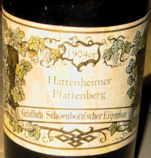 |
| Hattenheimer Pfaffenberg 1904 |
Another 20 years were added to the Hattenheimer Pfaffenberg of Schönborn Castlewhich at first clearly showed its 100 years, especially on the nose. A first sip, however, did not reveal an emaciated wine. The density and length suggested that the wine only lacked a little fresh air. And so it was. After a few minutes, the bouquet began to blossom, revealing a deep, multi-layered scent of spices, red berries, dried fruit and wilted flowers. On the palate, a wonderful balance of density and elegance, quite pure, fine-juiced fruit, first-class acidity and complex aromatics, as deep as it was exciting and still gaining fruit with air intake. The finish kept you spellbound for minutes (96). Living history in the truest sense. Even after the hot summer of 1904, the harvest was abundant by the standards of the time - an average of 35 hectolitres per hectare!
Hare and rabbit were accompanied by three younger reds from our own estate: the "B" selections of Pinot Noir from 1999, 2000 and 2001. 99 was firmly structured and elegant at the same time, with pure Pinot fruit, slightly toasty notes and a mineral backbone (88) . Wood and toasty aromas as well as sweet cherry and berry fruit were even more pronounced in the 2000 , but it could not quite keep up with the finesse and depth of its predecessor. An open-hearted, decidedly harmonious Pinot Noir that is now a pleasure to drink (86). While Breuer's Pinot Noirs have always come exclusively from Rüdesheim vineyards, 2001 was the first year that the yield from the new Nonnenberg vineyards, planted with French clones, was used. The bouquet is deeper and more complex than that of its predecessors, with aromas of red and black berries, spices and minerals. Youthful and very juicy in the mouth, tightly knit, crystal clear fruit, mineral on the palate, excellent structure and length (90+).
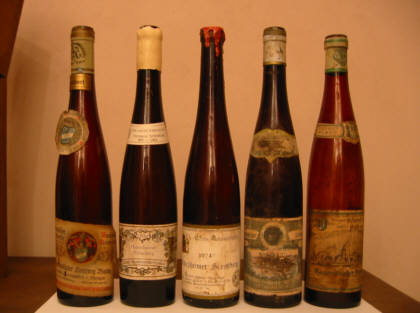 |
| Vitally old |
Pinot noirs were also served with raw milk cheeses and desserts (apple pie and thyme parfait), this time, however, without exception, noble sweet wines. The first wine was an Assmannshäuser Höllenberg Spätburgunder Weißherbst Eiswein Auslese from 1970, the vintage that, with an all-time yield record of 134.2 hectolitres per hectare, exemplifies an unfortunate time in German viticulture when quantity was far more important than quality and from which the industry has still not finally cured itself. The wine was correspondingly tightly measured, slender, with animal and vegetable notes on the nose (liver and capers!), some candied fruit and delicate sweetness, but also phenolic notes on the palate (78). Quite different is the Erbacher Siegelsberg Spätburgunder Weißherbst Trockenbeerenauslese from Rheinhartshausen Castle from the botrytis year 1976: very deep and concentrated already in the nose, of dried fruit, rock candy, red berries, wilted roses and some varnish. In the mouth dense, powerful and concentrated, again notes of candy, caramel and dried fruit, clear minerality, great depth and length, should last for half an eternity (94). The '77 Assmannshäuser Höllenberg Spätburgunder Weißherbst Eiswein Beerenauslese of the Staatsweinguts had dried fruit, candy and caramel to offer, but revealed a much spicier and less fruity character on the nose than the 76, with notes of Turkish honey, chestnuts and brioche. On the palate, the contrasts were even greater: although clearly fruity, the '77 was rather lean, acidic and vegetal, with notes of rock candy again in the background and noticeable tannins on the finish. The complex aroma contributes significantly to the positive overall impression (88). The tasting was concluded by another ice wine from the Assmannshäuser Hollenberg - this time an 83 - from the cellars of the Staatsweingut, which was far superior to its two predecessors of the same origin from the 70s: creamy, nutty-spicy aroma of candied fruit and curd cheese. Juicy and sweet in the mouth, with fine acidity, candy notes, curd again and in addition almost jam-like fruit on the palate, clear ice wine characteristics, some honey in the background, excellent depth and length (91).